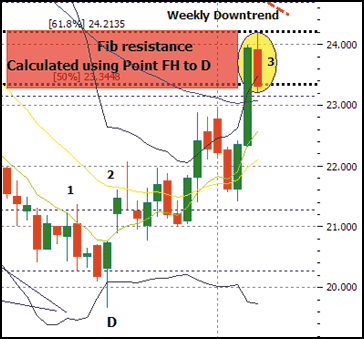Adjusting With Options
Adjusting A Long Call With The Synthetic Straddle
In this, the second and concluding part of this series, we focus on applying money management with the use of adjustments.
IN the January 2007 STOCKS & COMMODITIES, we began a case study of XM Satellite (XMSR) using a double bottom/Fibonacci butterfly chart pattern along with a multiple time frame analysis. In part 1, the reader was introduced to the characteristics of the Fibonacci-based butterfly pattern, the application of confirmation patterns, multiple time frame analysis, and candlestick entries. After reading that article, readers should have felt more confident about the trading process through the use of popular technical tools and methods.
The purpose of that article was to help traders turn an uncertain situation into a stronger, well-conceived alternative. This was accomplished by locating a limited risk position in the option market that satisfies our trade objectives better than the underlying instrument itself. We did so by focusing on how a trader might select a proper long call purchase based on the technical evidence, trade expectations, and the actual pricing of the call options.
Part 1 of the case study left off with the reasons behind the purchase of XMSR May 22.50 call options for $1 as our bullish technical setup was just under way (point 2 of Figure 1). In part 2, we shift the focus to applying money management through the use of adjustments.

FIGURE 1: XMSR, DAILY VIEW, 4/7/06. On this chart of XMSR you can see the adjustment zone.
SYNTHETIC STRADDLE
While there are many alternatives, for the moment we will examine the synthetic straddle. We will show the risk characteristics behind the strategy and walk the reader through one possible series of easy-to-understand adjustments. The approach and its adjustments will continue to make good use of a blend of practical money management and technical analysis, remaining consistent with our philosophy from the first installment. Traders should come away with an understanding of how this position might stack up versus more traditional money management. In addition, it might help answer whether this type of limited risk trade is suitable for you.
...Continued in the August issue of Technical Analysis of STOCKS
& COMMODITIES
Excerpted from an article originally published in the August 2007
issue of Technical Analysis of
STOCKS & COMMODITIES magazine. All rights reserved. © Copyright
2007, Technical Analysis, Inc.
Return to August 2007 Contents